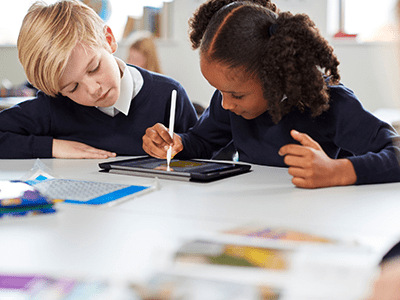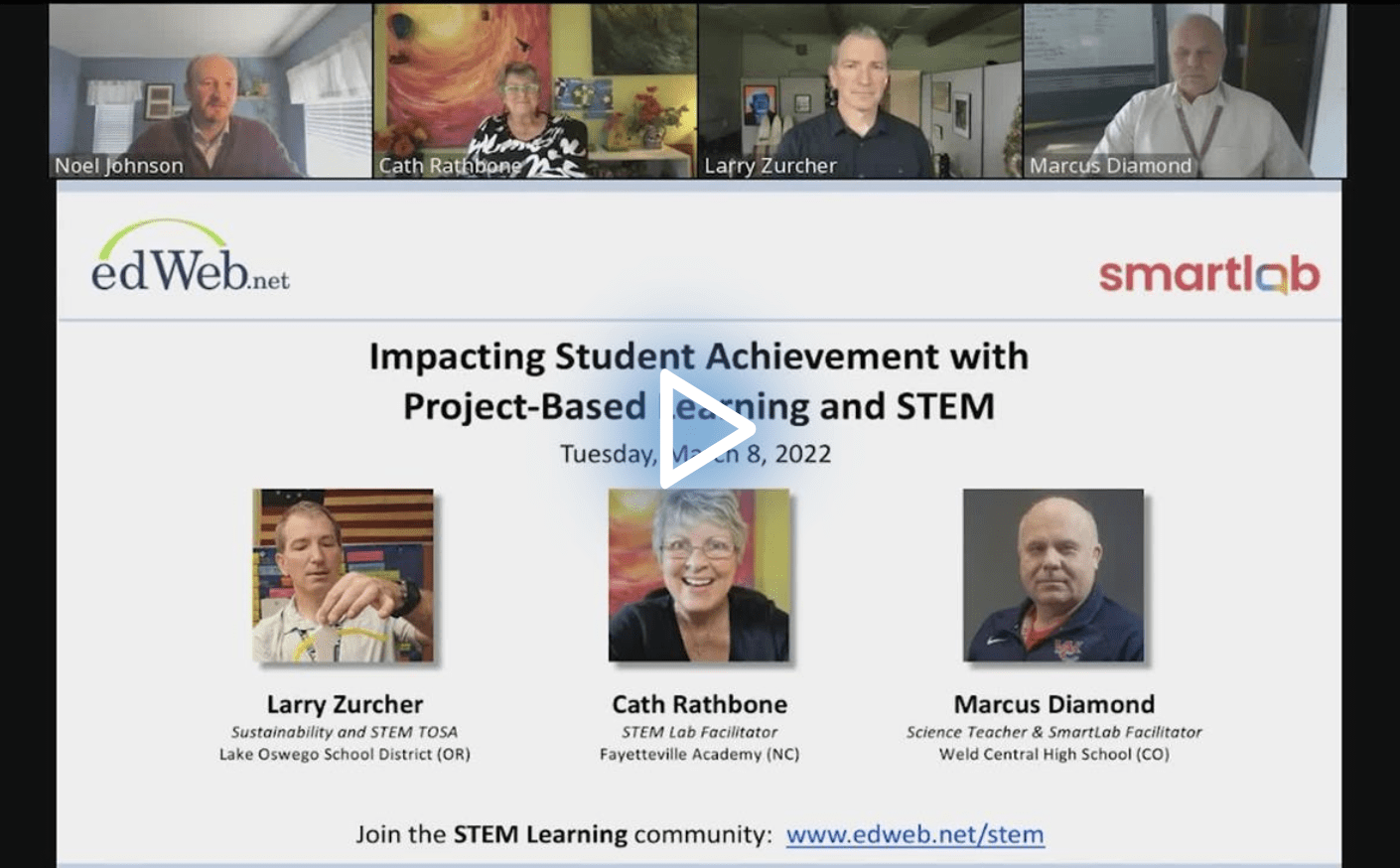Science Uninteresting? Not if It’s Project Based!
Watch the Recording Listen to the Podcast
Traditional science education in a nutshell: Students get lots of often-disconnected teacher-fed facts in a classroom, memorize procedures, read dull textbooks, and take a test to gauge recall.
BORING. Not the ideal way to immerse students in the excitement and possibilities STEM learning offers.
A better approach to STEM education is project-based learning (PBL), emphasized by veteran teachers in the edLeader Panel, “Impacting Student Achievement with Project-Based Learning and STEM.” Describing innovative, student-led initiatives they launched, the panelists highlighted research-based PBL practices that advance skill development, academic success, and a vast appreciation for science.
PBL Has Impact, the Research Says
PBLWorks describes PBL as a teaching method where students learn by actively engaging in real-world and personally meaningful (and quite fun!) projects.
Typically, they work for an extended time to investigate and respond to authentic, engaging, complex questions, problems, or challenges. Creatively addressing a real-world issue develops deep content knowledge, critical thinking, collaboration, and communication skills.
In partnership with Edutopia, university researchers, and several non-profit organizations, Lucas Education Research conducted studies revealing PBL’s significantly positive impact on student learning. A few general findings across studies include:
- Substantial improvements in student test scores on traditional assessment methods
- Expanded design of authentic learning experiences and socio-emotional learning opportunities
- Increased educational equity
- More focused development of career- and college-ready skill building
And most relevant: A yearlong study of third-grade science classrooms in Michigan showed that a curriculum aligned with the Next Generation Science Standards within a PBL methodology increased science assessment scores by 8% and advanced socio-emotional learning.
Elements of Effective Science PBL
Whether students are constructing a giant maze for a remote-control robot or a toothpick theme park, creating a design for an ice cream brand, or establishing a cinema company that uses drones to capture videos (yes, all STEM projects that panelists’ students created!), they apply a variety of real-world PBL practices and principles that propelled their science understanding.
Design
Project conceptualization and development require creative brainstorming and strategic thinking. Students learn how to design, starting from ideation (lots of it!) to mock-up iterations and prototyping. They set development timelines, determine a project’s longevity, decide on product names and colors, and determine what materials and resources to use (and what is readily available and affordable). These experiences heighten awareness of what is involved in creating and producing.
Teamwork and Collaboration
Students typically work in small groups (sometimes overseen by project managers or team leaders) on elements of a larger project, continually collaborating to bring the pieces together throughout the development process.
While the final product is the outcome, it’s not the most essential work element, explained Cath Rathbone, STEM lab facilitator from Fayetteville Academy in North Carolina.
“What matters most,” said Rathbone, “is that you worked on this whole thing together and implemented these different parts.” It’s not how perfectly students fare on their tasks but how they demonstrate responsibility for their jobs, collaborate and communicate with others to implement their part of the whole, work through development and scientific processes, and overcome challenges (and failures).
Market Research
As in the real business world, students conduct research to inform product needs and design and create partnerships. Rathbone’s students, for example, charged with developing an ice cream brand, examined lots of freezers filled with ice cream of all kinds.
The students of Marcus Diamond, science teacher and STEM facilitator at Weld Central High School in Colorado, first determined how to connect with district programs and departments and then explored the types of projects that would best “touch” the local community.
Expert Guidance, Support, and Entrepreneurial Connections
The real-world aspect of PBL truly comes alive for students when they interact with specialists. Rathbone’s students learned how to solder wires together from a local community member so they could navigate the circuitry required for their robot maze.
Diamond’s students, who set out to create a drone-based cinema company, realized they needed licensed drone pilots for the company to make money. Diamond became the expert: He learned how to pilot and earned his license.
Diamond’s students have formed entrepreneurial connections with local businesses, like a wedding planner who uses aerial images, a large reclamation company, and a few real estate agents. A success story: A video they made of a home for sale sold for 5K over the asking price by the buyers who had seen the video.
Academics, Grades, Curriculum
Teachers shape PBL in ways that benefit students and align with a school’s approach to academics, grading, etc. So, there is lots of room for unique PBL approaches.
Rathbone incorporates mathematics and language arts into her projects. Students created ice cream names using rhyming couplets, for example. And, oh, the clever variety: Cherry Berry, Felon Melon, Yoda Soda.
Writing, shared Larry Zurcher, STEM instructor at Lake Oswego School District in Oregon, is built into the district’s STEM programs. Students record their structured scientific thinking—idea of claim, evidence, reasoning in portfolios, enabling them to review the process, revisit strategies, overcome obstacles, etc. In each of the district’s elementary schools, students integrate science with social studies and literature in iLabs.
For grading, Diamond meets weekly with students one-on-one to grade their projects and to discuss and give feedback. Each quarter, they write a description of the job they are currently doing, culminating in what is essentially a job description compilation that is integral to their final grade.
Strategies for Instituting PBL
School leaders know PBL is beneficial. And so, when thinking about how to incorporate the method into districts and schools, they must be strategic and purposeful in its implementation, which varies in scope and construct across institutions.
Zurcher described his district’s steps to launch a comprehensive science-focused PBL strategy. While it’s a model unique to the Lake Oswego School District, it demonstrates the importance of a thoughtful development process.
The district examined its STEM vision. The long-range facilities planning committee looked at the research and how they wanted the students to learn. Makerspaces emerged as the tool to broaden science learning with a PBL focus. A local levee enabled the piloting of makerspaces.
With school leaders and teachers, Zurcher visited makerspaces in other states to gauge their impact on learning and student engagement. These observations shaped a structured model to pilot in select elementary and middle schools.
Teachers with PBL experience modeled the methodology, which district teachers observed to grasp how the method boosts learner engagement, and recognize the value of learning that allows learners to struggle and get unstuck, moving away from the more teacher-led instructional model.
Makerspaces are now a permanent part of the district’s STEM programming. Teachers find places in the Next Generation Science Standards for PBL-centered learning opportunities. Student learning has extended beyond the lab into the classroom, often designing and creating unique ways of demonstrating their learning. For example, one student produced a stop motion animation to demonstrate his understanding of division.
The best outcome? The makerspaces have also generated more interest in STEM learning among middle and high school students.
Learn more about this edWeb broadcast, “Impacting Student Achievement with Project-Based Learning and STEM,” sponsored by SmartLab Learning.
Watch the Recording Listen to the Podcast
Join the Community
STEM Learning: Full STEAM Ahead is a free professional learning community that provides educators, curriculum leaders, and industry members with a place to collaborate on bringing more science, technology, engineering, and mathematics into the classroom.

Blog post by Michele Israel, based on this edLeader Panel





Comments are closed.